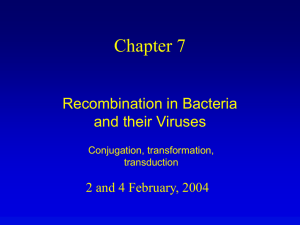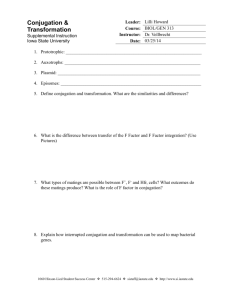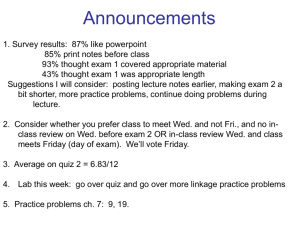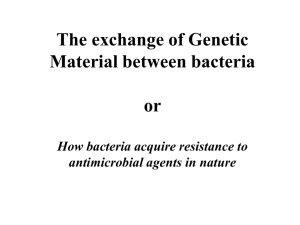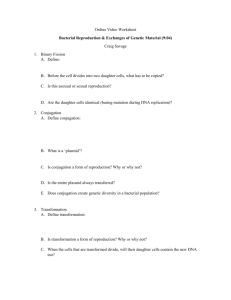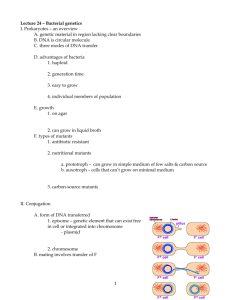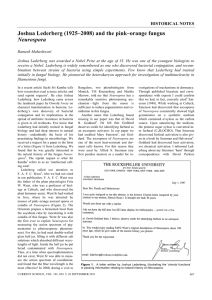24.11
advertisement
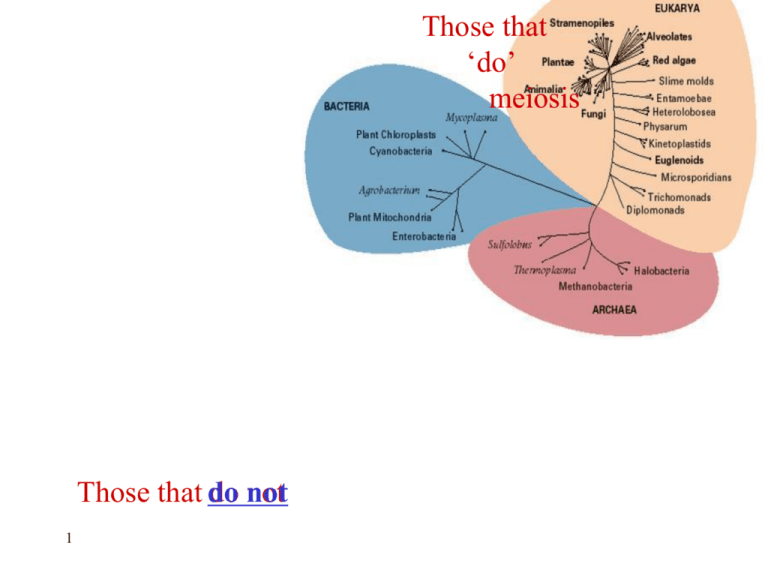
Those that ‘do’ meiosis Those that do not not 1 Four ways by which bacterial DNA can be transferred from cell to cell Non-obligatory processes… 2 Working with microorganisms: methods of growing bacteria in the laboratory Clonal, micro to macro, … see a single molecular event’s consequences 3 Bacterial colonies on staining medium Red colonies contains wild-type bacteria able to use lactose an energy source (lac+) The unstained cells are mutants unable to use lactose (lac-) 4 Model organism Escherichia coli Antonie van Leeuwenhoek 1632-1723 First to see bacterial cells and appreciate their small size “there are more living in the scum on the teeth in a man’s mouth then there are men in the whole kingdom” 5 Model organism Escherichia coli Named after its discoverer Theodore Escherich (1857-1911) pili 6 Joshua Lederberg 1925 – 2008 Edward Lawrie Tatum 1909-1975 In certain bacterium there was a type of sexual cycle including a crossing over like process Nobel Prize in Physiology or Medicine in 1958 I. II. III. 7 Bacterial conjugation 8 Physical contact between bacterial cells is required for genetic recombination 9 Lederberg and Tatum’s demonstration of genetic recombination between bacterial cells B+ 10 A+ Lederberg and Tatum’s demonstration of genetic recombination between bacterial cells 11 12 13 F+ F- 14 F+ + FF 15 Formation of high frequency recombinant strain (Hfr) F+ Hfr 16 Bacterial conjugation and recombination 17 Interrupted-mating conjugation experiments Francois Jacob 1920 (age 92) Elie Wollman (1917-2008) 1965 Nobel Prize in Medicine with Jacques Monod and André Lwoff Originated the idea that control of enzyme levels in all18 cells occurs through feedback on transcription Interrupted-mating conjugation experiments 19 20 Interrupted-mating conjugation experiments The point 21 O is now known to be the site at which the F plasmid is inserted 22 Time of entry mapping is not based on recombinant frequency the units are minutes, not RF The Hfr chromosome, originally circular, unwinds and is transferred to F- cell in a linear fashion, with the F factor entering last 23 Insertion of the F factor into the E. coli chromosome by crossing over 24 25 26 “One ring to rule them all, One ring to find them, One ring to bring then all and in the darkness to bind them” J. R. R. Tolkien, The Lord of the Ring 27 28 Fine scale mapping by recombinant frequency Incomplete genome Complete genome Merozygote 29 To keep the circle intact there must be an even number of crossovers 30 Only one of the reciprocal products survives 31 32 33 34 Don’t “LAST-IN MAPPING” Second technique for mapping - at high resolution galactose 35 Transferred fragment leu+ of Hfr chromosome arg+ met+ leu- arg- met- F- chromosome To examine the recombination of these genes must select for “trihybrids” exconjugants that have received all three donor markers To do this, we must first select stable exconjugants bearing the last donor allele, which in this case is leu+ 36 First select leu+ exconjugants and then isolate and test a large sample of these to see which of the other markers were integrated 37 38 39 40 41 4m.u 4% 9m.u 9% 4m.u 9m.u 87% Rarely recovered 42 F’ - duction 43 START HERE F’ F- F’-duction 44 45
